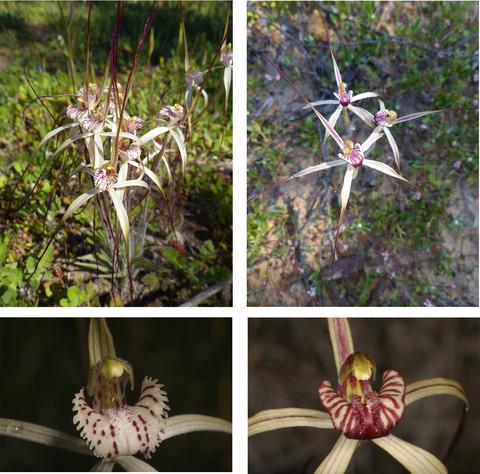当前位置:
X-MOL 学术
›
Plant Biol.
›
论文详情
Our official English website, www.x-mol.net, welcomes your feedback! (Note: you will need to create a separate account there.)
A specialised pollination system using nectar-seeking thynnine wasps in Caladenia nobilis (Orchidaceae).
Plant Biology ( IF 3.9 ) Pub Date : 2019-12-17 , DOI: 10.1111/plb.13069 R D Phillips 1, 2, 3 , B Bohman 4 , G R Brown 5, 6, 7 , S Tomlinson 2, 8 , R Peakall 3
Plant Biology ( IF 3.9 ) Pub Date : 2019-12-17 , DOI: 10.1111/plb.13069 R D Phillips 1, 2, 3 , B Bohman 4 , G R Brown 5, 6, 7 , S Tomlinson 2, 8 , R Peakall 3
Affiliation

|
Caladenia is a diverse Australian genus that is exceptional among orchids in having both species pollinated by food-seeking and sexually deceived insects. Here, we investigated the pollination of Caladenia nobilis, a species predicted to be food-deceptive due to its large, cream-coloured and apparently nectarless flowers. Pollinator observations were made using experimental clumps of flowers. Measurements of floral colour were undertaken with a spectrometer, nectar was tested using GC-MS, and reproductive success was quantified for 2 years. While C. nobilis attracted nine species of insect, only males of the thynnine wasp Rhagigaster discrepans exhibited the correct size and behaviour to remove and deposit pollen. Male R. discrepans attempted to feed from the surface of the labellum, often crawling to multiple flowers, but showed no evidence of sexual attraction. Most flowers produced little or no nectar, although some may provide enough sucrose to act as a meagre reward to pollinators. Floral colouration was similar to a related Caladenia species pollinated by sexual deception, although the sexually deceptive species had a dull-red labellum. Reproductive success was generally low and highly variable between sites and years. In addition to most visitors being of inappropriate size for pollinia removal, the lack of response to the orchid by several co-occurring species of thynnine wasp suggests filtering of potential pollinators at the attraction phase. Our discovery of a pollination strategy that may be intermediate between food deception and food reward raises the question, how many putatively rewardless orchids actually produce meagre amounts of nectar?
中文翻译:

一种特殊的授粉系统,该系统使用花蜜求百里香(黄兰科)中的寻求花蜜的胸腺黄蜂进行授粉。
卡拉德尼亚(Caladenia)是澳大利亚的一种多样的属,在兰花中是例外的,因为这两种物种都被觅食的昆虫和性欺骗的昆虫授粉。在这里,我们调查了Caladenia nobilis的授粉,该种由于其大的,奶油色的,显然是无花蜜的花朵而被预测具有食物欺骗性。授粉观察是使用实验性的花丛进行的。用分光光度计测量花色,使用GC-MS测试花蜜,并量化2年的繁殖成功率。尽管诺曼梭菌吸引了9种昆虫,但只有胸腺黄蜂Rhagigaster Discrepans的雄性才具有去除和沉积花粉的正确大小和行为。雄性河豚(R. Discrepans)试图从the的表面觅食,经常爬行到多朵花,但没有证据表明有性吸引力。大多数花只产生很少或没有花蜜,尽管有些花可以提供足够的蔗糖以作为授粉媒介的微薄奖励。尽管有性欺骗的物种有暗红色的标签,但花色与通过性欺骗授粉的相关的加德尼亚属物种相似。生殖成功率通常较低,并且在地点和年份之间差异很大。除了大多数游客的花粉去除大小不适当外,几种同时出现的胸腺黄蜂对兰花的反应不足,这表明在吸引阶段可能的传粉媒介被过滤掉了。我们发现一种可能介于食物欺骗和食物奖励之间的授粉策略提出了一个问题,即实际上有多少假定无奖励的兰花产生少量的花蜜?
更新日期:2019-12-17
中文翻译:

一种特殊的授粉系统,该系统使用花蜜求百里香(黄兰科)中的寻求花蜜的胸腺黄蜂进行授粉。
卡拉德尼亚(Caladenia)是澳大利亚的一种多样的属,在兰花中是例外的,因为这两种物种都被觅食的昆虫和性欺骗的昆虫授粉。在这里,我们调查了Caladenia nobilis的授粉,该种由于其大的,奶油色的,显然是无花蜜的花朵而被预测具有食物欺骗性。授粉观察是使用实验性的花丛进行的。用分光光度计测量花色,使用GC-MS测试花蜜,并量化2年的繁殖成功率。尽管诺曼梭菌吸引了9种昆虫,但只有胸腺黄蜂Rhagigaster Discrepans的雄性才具有去除和沉积花粉的正确大小和行为。雄性河豚(R. Discrepans)试图从the的表面觅食,经常爬行到多朵花,但没有证据表明有性吸引力。大多数花只产生很少或没有花蜜,尽管有些花可以提供足够的蔗糖以作为授粉媒介的微薄奖励。尽管有性欺骗的物种有暗红色的标签,但花色与通过性欺骗授粉的相关的加德尼亚属物种相似。生殖成功率通常较低,并且在地点和年份之间差异很大。除了大多数游客的花粉去除大小不适当外,几种同时出现的胸腺黄蜂对兰花的反应不足,这表明在吸引阶段可能的传粉媒介被过滤掉了。我们发现一种可能介于食物欺骗和食物奖励之间的授粉策略提出了一个问题,即实际上有多少假定无奖励的兰花产生少量的花蜜?



























 京公网安备 11010802027423号
京公网安备 11010802027423号